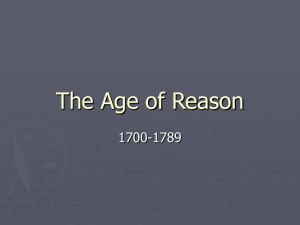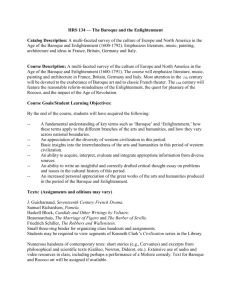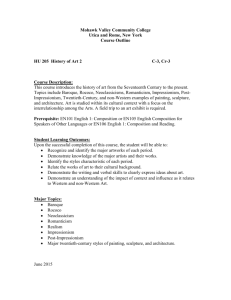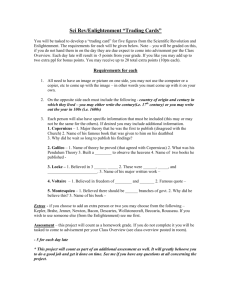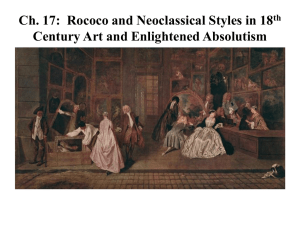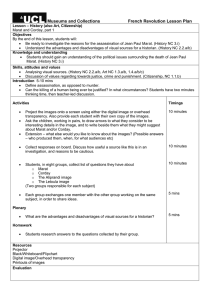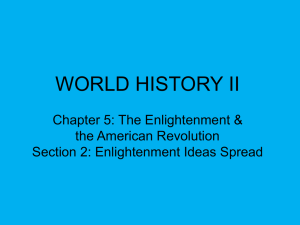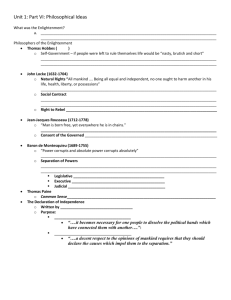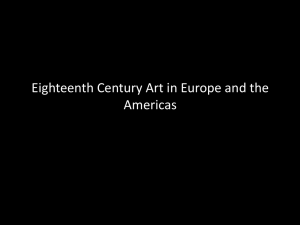Rococo & Enlightenement - Art History Teaching Resources
advertisement
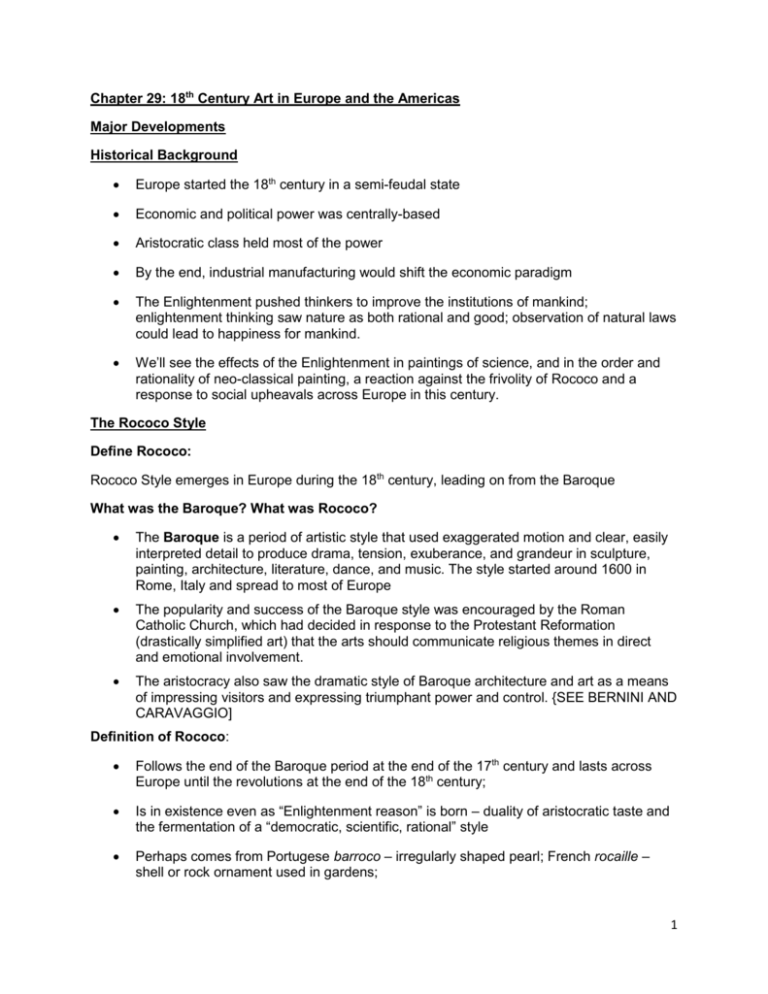
Chapter 29: 18th Century Art in Europe and the Americas
Major Developments
Historical Background
Europe started the 18th century in a semi-feudal state
Economic and political power was centrally-based
Aristocratic class held most of the power
By the end, industrial manufacturing would shift the economic paradigm
The Enlightenment pushed thinkers to improve the institutions of mankind;
enlightenment thinking saw nature as both rational and good; observation of natural laws
could lead to happiness for mankind.
We’ll see the effects of the Enlightenment in paintings of science, and in the order and
rationality of neo-classical painting, a reaction against the frivolity of Rococo and a
response to social upheavals across Europe in this century.
The Rococo Style
Define Rococo:
Rococo Style emerges in Europe during the 18th century, leading on from the Baroque
What was the Baroque? What was Rococo?
The Baroque is a period of artistic style that used exaggerated motion and clear, easily
interpreted detail to produce drama, tension, exuberance, and grandeur in sculpture,
painting, architecture, literature, dance, and music. The style started around 1600 in
Rome, Italy and spread to most of Europe
The popularity and success of the Baroque style was encouraged by the Roman
Catholic Church, which had decided in response to the Protestant Reformation
(drastically simplified art) that the arts should communicate religious themes in direct
and emotional involvement.
The aristocracy also saw the dramatic style of Baroque architecture and art as a means
of impressing visitors and expressing triumphant power and control. {SEE BERNINI AND
CARAVAGGIO]
Definition of Rococo:
Follows the end of the Baroque period at the end of the 17th century and lasts across
Europe until the revolutions at the end of the 18th century;
Is in existence even as “Enlightenment reason” is born – duality of aristocratic taste and
the fermentation of a “democratic, scientific, rational” style
Perhaps comes from Portugese barroco – irregularly shaped pearl; French rocaille –
shell or rock ornament used in gardens;
1
Charaterized by elegant designs and pastel color base; Frivolous, playful subjects;
Curves and dainty figures; Favored by aristocratic class which were more concerned
with pursuit of pleasure; Mainly developed in France in wake of the death of Louis XIV in
1715.
Fête galante paintings (see: Watteau) are an important part of the rococo period of art,
which saw the focus of European arts move away from the hierarchical, standardized
grandeur of the church and royal court and toward an appreciation for intimacy and
personal pleasures.
INTENTIONAL VISUAL REDUNDANCY; LOTS OF GOLD, STUCCO AND DECORATION; AN
EXTENSION OF THE BAROQUE.
Define Enlightenment:
The Enlightenment was loosely characterized as a set of values that came to
prominence during the 18th century and bolstered various revolutions and shifts in social
governance across Europe and America
It was not so much a cohesive movement, but rather at its core was a critical questioning
of traditional institutions, customs, and morals, and the emergence of a strong belief in
rationality and science.
Originating about 1650 to 1700, it was sparked by philosophers Baruch Spinoza (1632–
1677), John Locke (1632–1704), Pierre Bayle (1647–1706), physicist Isaac Newton
(1643–1727), and philosopher Voltaire (1694–1778).
The Enlightenment pushed thinkers to improve the institutions of mankind and to criticize
undemocratic forms of rule; enlightenment thinking saw nature as both rational and
good; observation of natural laws rather than blindly obeying religious ones. Meritocracy
(to a certain extent – based on those privileged enough to have an education).
We’ll see the effects of the Enlightenment in paintings: of science, and in the order and
rationality of neo-classical painting, a reaction against the frivolity of Rococo and a
response to social upheavals across Europe in this century.
How are the Rococo and Enlightenment connected?
Enlightenment was based in the salons of the aristocrats and often funded by them in part
(Catherine the Great of Russia supported Voltaire and Diderot), even while its writers and
philosophers argued against indulging the tastes of the rich.
Other developments of this period:
Italy and its Classical Revival emerges, this classical revival spreads across Europe,
along with the notion of The Grand Tour (Slide: Pompeo Batoni, Lord Thomas Dundas,
1764).
Pompeii and Herculaneum are uncovered in 1748 and 1738 respectively
2
SLIDE: Germain Boffrand’s Salon de La Princesse, Hotel de Soubise, Paris. Begun 1732.
After the death of Louis XIV in 1715 the French court and the accompanying aristocracy moved
from Versailles back to the city of paris. Social rooms were smaller than at Versailles, but no
less lavishly decorated.
-
Men and women held salons daily or weekly and the rooms were elaborately furnished.
-
Salons became the sites for witty displays of humor and manners, sophisticated
conversations, and a life dedicated to leisure.
-
Decorated with gold, silver, chandeliers, paintings, and mirrored walls just like there had
been at Versailles, with which to reflect candlelight.
Pastel colors for the walls, stucco details, light airy rooms and a visual “feast” for the eyes were
all elements of the Rococo interior.
Jean-Antoine Watteau, 1684-1721 (painted sophisticated or idyllic, idealized scenes for new
urban aristocrats who purchased paintings for their homes from city art dealers). SEE VIDEO.
Francois Boucher, 1703-1770 (gained patronage under Louis XV’s mistress Madame
Pompadour, worked on the decoration of royal palaces at Fontainebleau and Versailles, in
1765, became royal painter to the king, and was known for painting erotic pictures with loose
mythological underpinnings e.g. Girl Reclining (1751) nominally based on a Venus “type”). SEE
VIDEO
2) SLIDE: Jean Honore Fragonard, The Swing, 1766. Oil on canvas.
See Smarthistory: http://smarthistory.khanacademy.org/rococo.html
Fragonard (1732-1806) studied with Boucher, went to Rome at the age of 20 for the artistic
training – was there 1756-61 – and like Watteau and Boucher, Fragonard catered to the French
aristocracy who wanted to decorate their city homes.
The Swing combines suggested sensuality with a soft, pastel nature setting.
What did we learn from the reading? Do you “buy” Posner’s line of thought? Is there a
moral element (ie. does Fragonard tell us this behavior is right or wring?)
Why does the swinging figure appear in the 17th c? Emblematic of pleasure, erotic intent,
distinct from religious subject matter, the fickleness of women
-
Watteau began to use it; painted at Versailles in 1699; becomes the double-entendre par
excellence
-
Blindman’s buff, seesaw, swing
-
Allows landscape painting in
-
Clearly meant to be sensually explicit or titillating, supposedly commissioned by a
gentleman of the court for his pleasure house
Inspired by Watteau’s pleasures of Summer in which a swing also appears
Two lovers watched over by the swing pushing bishop in the background and the statuary –
VOYEURISM
-
3
Cupid holds his finger to his lips as if he may keep the secret (based on Falconet”s
sculpture of Cupid from 1757, done for Louis XV’s mistress, Madame de Pompadour)
- The young man makes a futile attempt to cover the view up the lady’s skirt with his hat, yet
his gaze is direct and enraptured
- Her gaze is directed straight down at his
- Almost farcical – she kicks off her shoe and it remains suspended in the air. Shoe =
metaphor for loss of virginity
- Humorous, sensual, and also capturing a particular moment in terms of the swing reaching
its highest point or climax, alluding to the suggested climax of emotion in the painting
- Perhaps a secular revision of Baroque art and the work of artists such as Bernini.
Fragonard’s Room at the Frick (Video: http://www.frick.org/virtual/fragonard_tour.htm)
This room is the setting for an ensemble of canvases by Fragonard and a remarkable group of
French eighteenth-century furniture. Four of these canvases — The Pursuit, The Meeting, The
Lover Crowned, and Love Letters — were commissioned in 1771 for Madame du Barry,
mistress of Louis XV, and were installed in a new pavilion on the grounds of her château at
Louveciennes. Upon their completion they were rejected in favor of a series commissioned from
Joseph-Marie Vien. In 1790 Fragonard brought the paintings to his native Grasse and installed
them in his cousin’s house, along with two additional large panels, four overdoors, and four
slender panels of hollyhocks. These masterpieces of rococo painting decorated the London
residence of J. Pierpont Morgan before Mr. Frick acquired them in 1915.
- Perhaps a secular revision of the movement we looked at directly before this, Baroque art
and the work of artists such as Bernini.
The Enlightenment
SLIDE: de la Tour portraits & the Encyclopedia
-
The critical reaction against artists like Boucher (and rococo art more generally) acquired its
most definitive and eloquent expressions in the writings and salons of the philosopher Denis
Diderot (1713–1784), though these texts were not widely disseminated until the nineteenth
century.
Like earlier critics, Diderot objected to Boucher's unapologetically artificial colors, which
were very often likened to women's cosmetics, and his tendency to use brilliant painterly
effects and sensual subjects over substantive, edifying narrative.
The critical reaction was not purely an artistic matter, however, but was connected to a
broader context of Enlightenment ideologies concerning reason and rational thought
upon which social interactions should be founded.
The Encyclopedia
The quintessential marker of the revolution in thought and culture that we now call the
Enlightenment is the Encyclopedia. It was a general encyclopedia published in France
between 1751 and 1772, with later supplements, revised editions, and translations.
It was edited by Diderot and Jean le Rond d'Alembert. The work comprised 28 volumes,
with 71,818 articles and 3,129 illustrations
At its beginnings the Encyclopedia was no more than a venture for profit, projected by a
shrewd French publisher. It was to be a translation of the Chambers’ Cyclopaedia
(1728), an extremely successful English reference work.
4
Once Diderot and D’Alembert were given full control of it, they proceeded to expand its
scope vastly. The work was to contain nothing less than the basic facts and the basic
principles of all knowledge; it was to be a sort of war machine of the thought and opinion
of the Enlightenment.
We now view the Encyclopedia more as a major historical event than as an original
contribution to any of the branches of knowledge.
Those who ranged themselves on the side of the encyclopedists in effect formed a party,
or the rudiments of one, which served as the spiritual predecessor for groups of
reformers who were to preside in large measure over the transformation of the
conditions of life in France and throughout the western world during the next generation.
Indeed, the Preliminary Discourse of the Encyclopedia could be regarded as the
manifesto of the French Enlightenment, at least in the retrospective view of the historian.
To be sure, it was not designed to be a pronouncement heralding or justifying
revolutionary political action as were the Declaration of Independence, the Declaration of
the Rights of Man, and the Communist Manifesto, but it expressed the spirit of an
intellectual and emotional revolution going on in the eighteenth century that in one way
or another lay in the background of each of these.
It breathed a confidence that man, through his own intelligent efforts, could transform the
conditions of human life and that the beginning of that revolution could already be seen
in the sciences and arts.
"If exclusive privileges were not granted, and if the financial system would not tend to
concentrate wealth, there would be few great fortunes and no quick wealth. When the
means of growing rich is divided between a greater number of citizens, wealth will also
be more evenly distributed; extreme poverty and extreme wealth would be also rare."
(Wealth, Diderot)
SLIDE: Chardin
Supplementary Slides: Bernard Lépicié, Greuze
Chardin did not attend the best art academy, he never traveled to Italy (in fact, he only
once left Paris, for an audience with Louis XV in Versailles), he did not have a studio of
pupils, he was not a prolific painter (about one-third of his 300 or so surviving paintings
are copies), he was never acclaimed by his peers and he did not paint the historical and
religious works that the French Academy's ''doctrine of hierarchy'' considered the most
important.
Rather, he worked alone and slowly, concentrating on still life in his youth, opting for
genre paintings in his middle years and then returning to still life between the ages of 50
and 70.
Jean-Siméon Chardin was one of the major artists of still life paintings and genre scenes
(the depiction of ordinary people in everyday life) in the eighteenth century. He was
admired by Diderot, Denis for the seriousness of his subjects, which inspired virtue and
refined manners, and it is believed that he educated Diderot in his understanding of art
and aesthetics.
Chardin began still life paintings about 1725. Like the genre scenes, they portrayed
kitchen utensils and food in simple, rustic, middle class settings.
5
By 1728, Chardin was accepted into the Royal Academy as a painter of animal and fruit
subjects, the lowest category for the official art world.
Chardin began to paint figurative genre scenes and reached the pinnacle of success
between 1735 and 1750.
The honest virtue of the middle class was a recurring theme in Chardin's work. In Saying
Grace, of 1740, an austere home is the backdrop for a scene representing a mother
teaching her child a prayer at the dinner table in appreciation for their humble meal.
Unlike other genre painters of the time, Chardin portrayed women with dignity and gave
them an important role in the perpetuation of family values.
Chardin remained a dedicated and active member of the Royal Academy but died in
obscurity in Paris in 1799. During the nineteenth and twentieth centuries his refined
compositions inspired still life painters.
Art & The Market
Transition: the beginnings of a democratization of knowledge also paralleled the
democratization of art and its consumption through the medium of the print, and the
messages with which artists chose to embed in their works. Quite the opposite of
Fragonard’s swinging figures was the English satirical artist William Hogarth.
5) SLIDE: Hogarth & printing
William Hogarth’s (1697 – 1764) moralizing attitudes presented as humorous commentary on
the farce of modern upper middle class and aristocratic life, certainly fit with the civic agendas
and elevating aspirations of the Enlightenment Age of Reason.
See Watteau and Gersaint article – quotes on printing
See also Catalogue: Colorful Impressions: The Printmaking Revolution in Eighteenth
Century France, by Margaret Morgan Grasselli et al. Washington, DC: National Gallery of Art,
2003.
During the second half of the 18th century in France, newly invented engraving and
etching techniques were combined with new ways of printing a single image from
multiple plates.
Thus, for the first time, full-color prints could be created from just four basic colors: red,
yellow, blue, and black. Within a matter of decades, thousands of images were
produced, including some of the most complex and beautiful color prints ever made.
Color was in fact a regular ingredient in prints from their invention in the early 1400s, but
at that time color was always applied by hand.
The breakthrough came in the 1720s when the German artist Jakob Christoffel Le Blon
discovered that full-spectrum color prints could be created from only four basic inks-blue, red, yellow, and black--printed one on top of the other from separate copperplates.
Le Blon's intention was to produce affordable, full-color reproductions of paintings
The names of the printmakers who pioneered these techniques--Bonnet, Demarteau,
Janinet, Descourtis, and Debucourt, to name a few--are not well known today, but the
artists whose compositions they engraved rank among the most famous of the 18th
century--Boucher, Watteau, Fragonard, among others.
6
Then, artists like Hogarth took on the technique for an entirely different message.
The new color prints enjoyed an enormous commercial success. Advertised as "printed
paintings" and "engraved drawings," they allowed the middle classes to show their taste
and refinement by hanging on their walls replicas of the works of art that hung in the
mansions of aristocrats and members of the royal court.
Skilled printmakers catered to this new market, turning out thousands of different images
over a period of just a few decades.
SLIDE: William Hogarth, The Marriage Contract, from “Marriage a la Mode.” 1743-45
-
Hogarth believed that art should contribute to the moral good of society, especially as
England was on the cusp of the industrial revolution and class boundaries were shifting. A
good example needed to be set.
-
The middle class in mid-18th century England could afford to buy smaller painted scenes,
and also prints, which Hogarth saw as a market niche and capitalized on.
-
The print allowed Hogarth to maximize his profits and reach as many people with his
moralizing message as possible.
-
Hogarth’s Marriage a la Mode consisted of a sequence of six pictures inspired by john
Addison’s 1712 essay in the Spectator promoting marriage based on love rather than on
aristocratic machinations. Seems a suitable subject matter for an age of “reason” rather
than antiquated traditions of older class systems.
-
The Marriage Contract portrays the farcical handing over of an aristocratic son by his gouty
father to a new wealthy breed of merchant and the daughter he wants to marry off into good
society.
-
Hogarth wanted to create a style of art that was straightforward and easy to read, one that
would make social prpgress, shun the old-fashioed and decadent ideals of the aristocratic
classes, and effect instruction of audiences through dry humor.
-
Young aristocratic son on the far left, merchant’s daughter unhappy about the exchange,
wealthy merchant dressed brashly in red, and the aristocratic father pointing to his family
tress on the right.
The sequence progresses to show the effects of an arranged marriage – affairs, sexually
transmitted diseases, murder, social disgrace and, finally, death when the woman poisons
herself. Drama played out in easy-to-read scenes so the public would be able to understand the
narrative.
The last scene, the Death of the Countess:
The only people showing any sorrow for her death are her daughter and old
maidservant.
The child's legs are fitted with calipers, indicating she has rickets (a disorder that
contemporary commentators associated with over-indulgence — similar to the old Earl's
gout in the first scene — rather than deprivation).
7
The child has a black patch on her neck indicating that she has contracted syphilis from
her parents. The patch could also indicate scrofula; in either case a possible indication
that the child will not live long after her mother.
The congenital handicaps visited upon the child by her parents are compounded by the
final irony that as a female, she will not inherit her family titles. The family tree that the
old Earl so proudly displays in the first scene has come to an end, totally destroyed by
those who were charged with its preservation.
SLIDE: Joseph Wright of Derby, An Experiment on a Bird in the Pump, 1768. Oil on
canvas.
A similar spirit of rationality pervades Joseph Wright of Derby’s work, An Experiment on a Bird
in the Pump.
-
the Industrial Age, a sense of proto-Romantic drama and Enlightenment interest in science
all comes together in this work
-
Wright belonged to the Lunar Society, a group of progressive industrial, Enlightenment men
who met monthly in Birmingham, England, to exchange ideas about science and
technology.
-
In the same manner Hogarth tired to popularize his moral agenda through prints, Wright
painted a series of scenes to get people excited about science.
-
A traveling scientist is shown demonstrating the formation of a vacuum by withdrawing air
from a flask containing a white cockatoo, though common birds like sparrows would
normally have been used. Air pumps were developed in the 17th century and were relatively
familiar by Wright's day. The artist's subject is not only scientific invention, but a human
drama in a night-time setting.
-
The bird will die if the demonstrator continues to deprive it of oxygen, and Wright leaves us
in doubt as to whether or not the cockatoo will be reprieved. The painting reveals a wide
range of individual reactions, from the frightened children, through the reflective
philosopher, the excited interest of the youth on the left, to the indifferent young lovers
concerned only with each other.
-
The figures are dramatically lit by a single candle, while in the window the moon appears.
On the table in front of the candle is a glass containing a skull, a reference to the mortality
of both the subject, the bird, and the viewer. MORAL RESONANCE.
Neoclassicism in Britain – the Classical revival
During the 18th century in England, poet Alexander Pope translated work by the Ancient Greek
epic poet Homer into English; Pope wrote his own poetry in iambic pentameter, the rhythm of
Classical poetry; and aristocratic women started to wear white muslin gowns to look “classical”.
The craze for classical aesthetics was in full force.
See Wright’s Corinthian Maid
SLIDE: Richard Boyle (Lord Burlington), Chiswick House, West London, England. 172429. CARRIED ON IN VIDEO WITH STOURHEAD ESTATE IN WILTSHIRE, GARDEN
LADSCAPED BY A PROTÉGÉ OF BURLINGTON.
8
COMAPRISON SLIDE: Palladio, Villa Rotunda, Vicenza. Begun 1560s
-
Architect Lord Burlington was studying Palladio’s plans. Palladio was a Venetian architect
heavily influenced by classical architecture and Alberti’s principles of proportion who built in
Venice in the 16th century, almost 200 years before the neoclassical revival in England.
-
In 1715 C. Campbell’s publication ‘Vitruvius Britannicus’ and G. Leoni’s edition of Palladio’s
‘Four Books’ were fundamental influences for English and later European architecture
forever.
-
Palladio’s ideas were reflected in works of architects like Lord Burlington, especially Villa
Rotunda, Palladio’s masterpiece
-
The VR’s symmetrical plan, domed central hall, four porticos entrances with pediments
supported by ionic columns can be recognised in works like Chiswick House where the
main principles were harmony and classical proportion, lightness of facades and symmetry.
-
Lord Burlinton engaged William Kent (1685-1748) to decorate the interior of the house, and
to design the gardens in a manner that radically moved away from the highly manicured
style of the French court at Versailles or Baroque formality to a style which begun at
Chiswick, the English landscape garden.
-
ELG – designed to look deliberately wild, often featuring a “folly” or miniature architecture in
the idealized, idyllic landscape.
18th Century France Reacts against Rococo, and Neoclassicism becomes the style of the
Revolution
The threat of Revolution was made good on both sides of the Atlantic.
Both the French Revolution (1789) and the American Revolution (1776-77) changed
daily life immeasurably. The aesthetic style that became associated with the new
democratic approach to shaping a nation was the Classical style, admired by
Enlightenment thinkers, and posited as a rational way to arrange space and
decoration – harking back to the classical style of the democratic ancent Greeks.
There was a strong reaction against Rococo tendencies in France from the 1760s,
and although the style doesn’t die out by any means, the Neoclassical style is
bolstered by philosophers of the Enlightenment Age calling for an art aesthetic that
will reflect reason.
What was the spark for the Revolution?
Louis XVI wanted to raise taxes. He wanted a committee of high-ranking clergy and
aristocrats to back him, but they were unwilling to become the target of public criticism.
They advised the king to summon the Estates General, a political body composed of 300
elected representatives of the aristocracy, an equal number of the clergy and 600
members of the Third Estate. This was unexpected, for although it has been in
existence since the 14th c, the Estates General had not been summoned since 1614.
9
The Estates. First-clergy. Second-nobility. Third-middle class and peasants
Advisory body only, No real legislative power.
They first met in May, 1789. The aristocrats and clergy, not surprisingly, sided with the
king. The Third Estate not only opposed the tax increase, they called for reform of the
tax system and the government.
They were convinced they could never be heard within the system of the Estates
General and they formed a new government entity, the National Assembly.
At a meeting at an indoor tennis court (because they were locked out, barred from the
official meeting room), they swore they would not disperse until they had given
France a new constitution.
SLIDE: David, Oath of the Horatii, 1784
MANIFESTATION OF STATE LOYALTY; MANIFESTO FOR NEOCLASSICAL STYLE
Jacques Louis David’s painting was made just before the French Revolution hit.
- David chose an episode in Roman history for his first royal commission in 1784. A Prix de
Rome laureate in 1776 and a member of the Académie, he wanted to launch his public career
by creating a stir with a radically innovative picture.
- HORATII VS. CURATII - DEFEAT OR DIE FOR COUNTRY In the 7th century BC, to put an
end to the bloody war between Rome and Alba, both cities designated champions: the former
chose the Horatii, the latter the Curiatii. The two families were linked by marriage. JacquesLouis David depicts the Horatii swearing to defeat their enemies or die for their country. On the
right, the grief-stricken women of the family already fear the worst: Sabina, the sister of the
Curiatii and wife of the eldest of the Horatii, and Camilla, the sister of the Horatii and betrothed
to one of the Curiatii, hang their heads in sorrow, while behind them, the mother of the Horatii
hugs her grandchildren.
- LEAVE ROCOCO: He forsook the amorous and mythological subject matter of his first
teacher, Boucher, for the Roman historians. He presented the finished canvas in his studio in
Rome in 1785, then at the Paris Salon later that year, on both occasions to acclaim.
- NEW STYLE OF NEOCLASSICISM The composition is broad and simple, with the life-size
figures arranged in a frieze in the foreground, as on Roman sarcophagi and Greek vases.
- The figures are separated by large empty spaces in a stage-like area shown head-on. David
emphasizes the room's geometry. The harsh, slanting light gives the figures their relief, and their
contrasting characters are conveyed using different forms.
- He gives the men energetic bodies constructed out of straight lines and dresses them in vivid
colors, while the women are all sinous curves and muted colors. GENDER DIFFERENCE The
painting became the model throughout Europe for the new style of painting that is art historically
now termed neoclassicism.
SLIDE: David, The Death of Marat, 1793
10
On 13 July 1793, David's friend Marat was assassinated by Charlotte Corday with a knife
she had hidden in her clothing. It was the execution of Louis XVI under pressure and a fixed
trial by the Jacobins that lead to the death of Marat
What do we see here? How would we describe this?
Jean-Paul Marat (May 24, 1743 – July 13, 1793), was a Swiss-born French scientist and
physician who made much of his career in the United Kingdom, but is best known as an
activist in the French Revolution. Radical Jacobin, part of the reign of terror
He was a journalist, exerting power through his newspaper, The Friend of the People,
L'Ami du peuple.
He advocated the September Massacres in which thousands of political prisoners were
murdered, and established the Committee of Surveillance, whose declared role was to
root out counter-Revolutionaries (Marat composed the death lists from which those
suspected of political crimes).
One of his victims may have been the chemist Antoine Lavoisier (portrait hangs at the
Met)
In 1789, when Marat had 22 Girondists arrested, Charlotte Corday began to consider
killing him.
The execution of King Louis XVI, January 21, 1793, and the denunciation of Marat by
Jacques Pierre Brissot, a leading Girondist, helped her finally decide to do so.
Who was Charlotte Corday?
She travelled from Caen to Paris on July 9, 1793.
She bought a dinner knife at the Palais-Royal, and wrote her Speech to the French who
are Friends of Law and Peace, explaining her actions.
She went to Marat offering to inform him about a planned Girondist uprising in Caen.
She was initially turned away, but on a second attempt on July 13, Marat admitted her into
his presence.
He conducted most of his affairs from a bathtub because of a debilitating skin condition.
Marat copied down the names of the Girondists as Corday dictated them to him. She
pulled the knife from her scarf and plunged it into his chest.
Corday was a Girondin, and her action provoked reprisals in which thousands of the
Jacobins' adversaries – both royalists and Girondins – were executed on supposed
charges of treason.
The entire National Convention attended Marat's funeral.
The assassination did not stop the Jacobins or the Terror: Marat became a martyr, and
busts of Marat replaced crucifixes and religious statues that were no longer welcome
under the new regime.
At trial, Corday testified that she had carried out the assassination alone, saying "I killed
one man to save 100,000." It was likely a reference to Maximilien Robespierre's words
11
before the execution of King Louis XVI.
Four days after Marat was killed, Corday was executed under the guillotine.
The anti-female stance of many revolutionary leaders was increased by Corday's actions.
The Revolution now turned with full force on Marie Antoinette, the king's imprisoned
widow.
Traditional interpretation = we are left to compare Marat’s death with that of Christ – to
see it as a martyr’s death for the “salvation of the people.”
-
Is this a history painting or a portrait?
-
Secular or religious?
-
Tony Halliday argues for secular - both public monument and private focus of
grief, two tropes active in this period in France.
-
Ancient roman death mask rather than martyr portrait. Secular, not religious.
Classical, not Christian.
-
The Death of Marat, 1793, became the leading image of the Terror and immortalized both
Marat, and David in the world of the revolution. This piece stands today as “a moving
testimony to what can be achieved when an artist’s political convictions are directly
manifested in his work".
-
A political martyr was instantly created as David portrayed Marat with all the marks of the
real murder, in a fashion that greatly resembles that of Christ or his disciples. The subject
although realistically depicted remains lifeless in a rather supernatural composition. With the
surrogate tombstone placed in front of him and the almost holy light cast upon the whole
scene; alluding to an out of this world existence.
-
“Atheists though they were, David and Marat, like so many other fervent social reformers of
the modern world, seem to have created a new kind of religion.” At the very center of these
beliefs, there stood the republic.
SLIDE: MONITCELLO, 1769-1809, Virginia
The Classical Style was also used in the 18th century in America to denote qualities of
independence, new democracy, and Enlightenment.
-
Perhaps the most famous architect working in the Neoclassical style was Thomas
Jefferson, third president of the USA and author of the Declaration of Independence.
-
He designed the University Of Virginia main campus (1817-26) and Monicello, his home,
(1769-1809)
-
He taught himself Italian so he could read palladio, the 16th century architect who had
inspired british architects.
-
He looked to Ancient Greece and Roman architectural styles as these epitomized progress
and democracy to him.
12
-
His house was also full of gadgets, and his farm used progressive methods of famring. He
collected and displayed artworks from all over the world. Connection tot hepast.
-
Contrary to this, however, was the fact that Monticello was built on the labor of enslaved
African-Americans who were not part of this new democracy.
See video (to at least 7 min 15)
13

